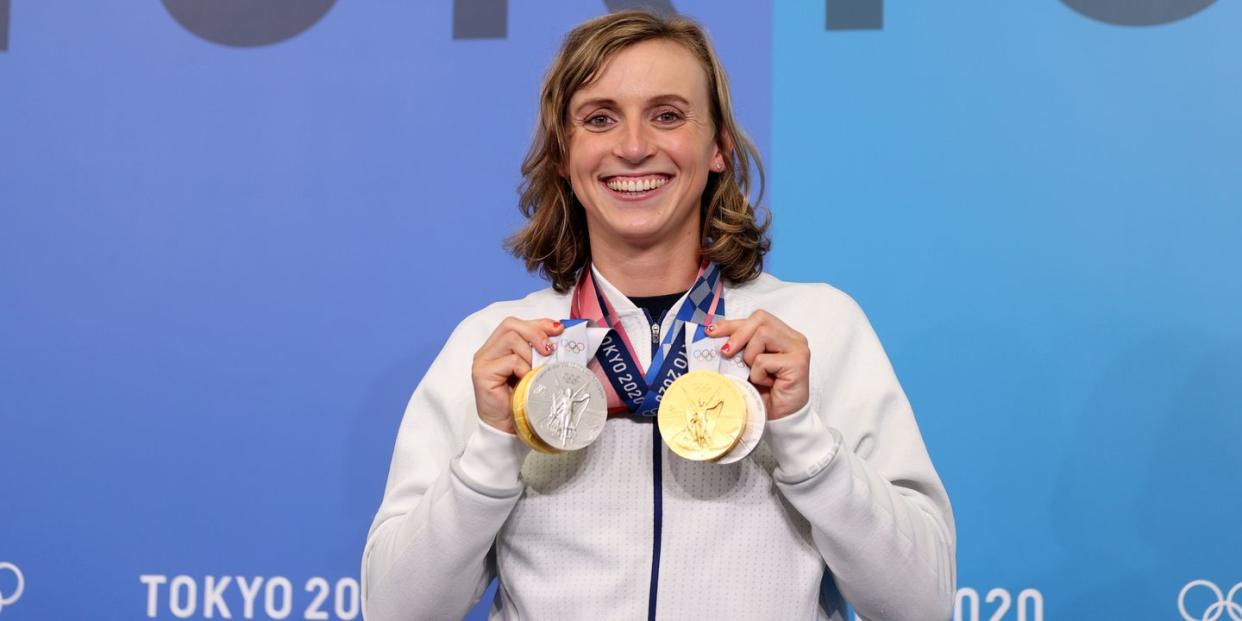What Katie Ledecky Eats in a Day to Stay Strong, Fueled, and Olympics-Ready

- Oops!Something went wrong.Please try again later.
Katie Ledecky is one of the most celebrated athletes for a reason. The 24-year-old sat down with Prevention to chat about her many successes, which includes seven Olympic gold medals, six of which are individual golds—winning Ledecky the coveted record for the most individual gold medals of any female U.S. Olympian ever. And as if that’s not enough, she’s only second to Michael Phelps for most individual gold medals for any Olympic swimmer.
Most recently, Ledecky made a splash in the 2020 Tokyo Olympics, bringing home two gold medals in the 1,500-meter freestyle and 800-meter freestyle races and two silver medals in the 400-meter freestyle and 4x200-meter freestyle relay.
But to crush goals that big, she has to crush tough workouts and fuel hard to achieve her record-breaking times. So what does Ledecky do to make sure she's full, focused, and ready to win? Here’s a peek into her everyday diet and training routine.
What Katie Ledecky eats in a day
Ledecky is no stranger to a nutritious-yet-delicious diet. Photos on her Instagram stories show everything from avocado toast topped with eggs to honey mustard chicken with potatoes and veggies to Christmas cookies and chocolate lava cake.
But Ledecky’s day-to-day meal plan during training season is pretty straightforward. She cooks her own meals and typically focuses on a nutritious plate of whole foods over supplementing meals with protein powders or vitamins. Here’s what Ledecky eats in a day:
Breakfast
She likes to fuel her morning workouts right, so breakfast is often the only thing in Ledecky’s stomach. A reliable go-to? Fiber-rich oatmeal with banana and berries, she says.
Post-workout snack
For her post-workout fuel, Ledecky regularly has a granola bar and guzzles chocolate milk as a recovery drink. She likes chocolate milk for healthy mix of protein and carbs, and a snack for an extra bit of fuel. “And I try to get a full meal within an hour of my practice,” she says.
Lunch
For her mid-day meal, she keeps it simple—two eggs with a carb (like bread or a tortilla) and vegetables.
Dinner
A combination of protein (like chicken, steak, or salmon) and a carb (like rice, vegetable, or pasta) rounds out her day.
When Ledecky isn’t training, she doesn’t stray much from her go-to meal plan. She says she doesn’t typically take more than two weeks off at a time and likes to stick to her routine, because she knows she feels good when she follows it.
How Katie Ledecky trains for the Olympics
To become a three-time U.S. Olympic swimmer and seven-time gold medalist, Ledecky’s training routine is understandably intense. From pool workouts to weight room sessions, she trains her hardest every day to prepare her body for strenuous competitions.
“I swim 10 times a week, typically,” she says. This is broken down into two swim sessions Monday, Tuesday, Thursday, and Friday, and one swim session on Wednesday and Saturday. After every pool session, she’ll do a quick cool-down (or as pro swimmers call it: a warm-down) in the pool to recover from pushing her body to the max. Then she takes Sundays off completely to rest.
In addition to swimming drills in the pool, Ledecky also hits the weight room Monday, Wednesday, and Friday to keep her body strong. In fact, her training for the Olympics didn’t really change her schedule, because as a professional athlete, she’s constantly training for the next competition.
“It’s quite a bit of training. It doesn’t really change in an Olympic year. We have other big meets throughout the four-year, in this case five-year, cycle,” she says.
That extra year of practice due to COVID-19 made training a little tricky, but Ledecky made it work as best she could. During the early days of quarantine, she posted to her Instagram videos of at-home workouts and practicing starts outside of her home.
She also turned to a neighbor for help when her Olympic training facility shut down. “This year was a little bit unique in that the first couple months of the pandemic we didn’t have our normal training facility, so I trained in a neighbor’s backyard pool for about three months,” she said. “But I tried to stick to as close to a training routine as I could and [eventually] was back in my normal training environment and was back to that same routine.”
You Might Also Like

